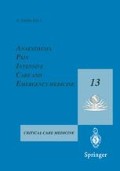Abstract
A hypnotic drug has to be able to achieve and maintain the suppression of consciousness (sleep) as its main activity. The pharmacological induced sleep is defined as hypnosis but it has not to be confused with that particular condition of consciousness susceptible to be influenced (hypnotic suggestion). The modern hypnotics available in the Italian anaesthesiological pharmacopoeia (propofol and midazolam) are able to work, in proportionally reduced doses, as sedative agents too; therefore, they can reduce or abolish the excitatory states or psychomotor agitation making patients calm and quiet. On the basis of a modulated and progressive central nervous system (CNS) depression, propofol and midazolam can produce either sedation or hypnosis. Therefore they can be injected intravenously to induce general anaesthesia and to maintain unconsciousness as the hypnotic component of a balanced anaesthetic technique just founding on the triad: hypnosis, analgesia and muscle relaxation. Without the suppression of consciousness (hypnosis) the last two components could not be able to attenuate the stress response during surgical procedures.
Access this chapter
Tax calculation will be finalised at checkout
Purchases are for personal use only
Preview
Unable to display preview. Download preview PDF.
References
Franks NP, Lieb WR (1994) Molecular and cellular mechanisms of general anaesthesia. Nature 367:607
Goodchild CS, Serrao IM (1987) Intrathecal midazolam in the rat: Evidence for spinally mediated analgesia. Br J Anaesth 59:1563
Niv D, Whitwam JG, Loh L (1983) Depression of nociceptive sympathetic reflexes by intrate-chal administration of midazolam. Br J Anaesth 55:541
Doenicke A, Roizen MF, Rau J et al (1996) Reducing pain during propofol injection: The role of the solvent. Anesth Analg 82:472
Simons PJ, Cockshott ID, Douglas EJ et al (1985) Blood concentrations, metabolism and elimination after a subanaesthetic intravenous dose of C-propofol to male volunteers. Postgrad Med J 61[Suppl 3]:64
Saint-Maurice C, Landais A, Cockshott ID et al (1987) Le propofol comme agent d’induction en anesthésie pédiatrique. Etude clinique préluminaire. Ann Fr Anesth Réeanim 6:269
Reddy RV, Moorthy SS, Dierdorf SF et al (1993) Excitatory effects and electroencephalo-graphic correlation of etomidate, thiopental, methohexital and propofol. Anest Analg 77:1008
Ebrahm ZY, Schubert A, van Ness P et al (1994) The effect of propofol and the electroencephalogram of patient with epilepsy. Anesth Analg 78:275
Borgeat A, Wilder-Smith OHG, Suter PM (1994) The non-hypnotic therapeutic application of propofol. Anesthesiology 80:642
Reves JG, Fragen RJ, Vinik HR et al (1985) Midazolam — Pharmacology and uses. Anesthesiology 62:310
Kronbach T, Mathys D, Umeno M et al (1989) Oxidation of midazolam and triazolam by human liver cytocrome P450 3A4. Mal Pharmacol 36:89
Strebel S, Kaufmann M, Guardiola PM et al (1994) Cerebral vasomotor responsiveness to carbon dioxide is preserved during propofol and midazolam anesthesia in humans. Anesth Analg 78:884
Bailey PL, Pace NL, Ashburn MA et al (1990) Frequent hypoxemia and apnea after midazolam and fentanyl. Anesthesiology 73:826
Laurent J (1989) Mècanismes d’action centraux et péripherique des benzodiasepines. In: Les benzodiazepines en anestésie-réanimation. Arnette, Paris, p 1–12
Khan LC, Lustik SJ (1997) Treatment of paradoxical reaction to midazolam with haloperidol. Anesth Analg 85:213
Borg PAJ, Krijnen HJ (1996) Long-term intrathecal administration of midazolam and Clonidine. Clin J Pain 12:63
Hughes MA, Jacobs JR, Glass PSA (1992) Context-sensitive half-time in multicompartment pharmacokinetic models for intravenous anesthesia. Anesthesiology 76:334
Author information
Authors and Affiliations
Editor information
Editors and Affiliations
Rights and permissions
Copyright information
© 1999 Springer-Verlag Italia
About this paper
Cite this paper
Mastronardi, P., Cafiero, T., Rossi, A.E. (1999). Hypnotics. In: Gullo, A. (eds) Anaesthesia, Pain, Intensive Care and Emergency Medicine — A.P.I.C.E.. Springer, Milano. https://doi.org/10.1007/978-88-470-2145-7_17
Download citation
DOI: https://doi.org/10.1007/978-88-470-2145-7_17
Publisher Name: Springer, Milano
Print ISBN: 978-88-470-0051-3
Online ISBN: 978-88-470-2145-7
eBook Packages: Springer Book Archive

